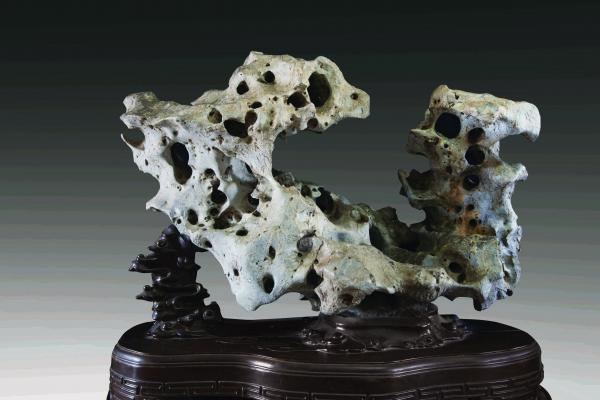According to legend, stones have been revered in China since remote antiquity, when they were presented as tribute to Emperor Yu, a mythical sage-ruler. Stones were prized and collected for display in gardens and interiors from the Han dynasty (206 BCE–220 CE) onward, and by the Tang dynasty (618–906) a true literature of stones had appeared. The tradition of stone collecting—which was to find its ultimate expression during the Ming dynasty (1368–1644)—focused on stones as representations of the primordial energies that created the universe. In addition, stones symbolized the human virtues of strength and endurance.
The most treasured stones were those with strange and bizarre shapes suggestive of remote and numinous mountain peaks or of Daoist paradises. Stones were appreciated for their dramatic and bizarre forms as well as the musical sounds they made when struck or tapped. The Chinese elevated such stones to the level of the most refined works of art, and venerated them as objects of contemplation and meditation. For centuries such stones have found great favor among traditional Chinese collectors, including literati and emperors.
In China “spirit stones” or “scholar’s stones” were valued on several levels. While they could convey considerable social status merely through their strange beauty, such stones were also seen as reflections of the basic structures underlying reality as understood by cosmologists. As the twelfth century writer Kong Chuan wrote in his preface to Du Wan’s Stone Catalogue of Cloudy Forest, “The purest essence of the energy of the heaven-earth world [the universe] coalesces into stone.”
It is evident from the earliest Chinese literature on the subject that stones were seen in this light—not as fixed, solid objects but as fluid and dynamic, capable of magical transformations. Certain stones were believed to have the ability to speak, to emit clouds and rain, to predict the weather, to move about of their own accord, and to heal. Fantastic stones, complete with peaks, ravines, and caverns, were perceived as mountains in miniature, embodying the same primal energies that made up the Five Sacred Peaks and the island-mountains of the Daoist immortals in the Eastern Sea. A strange stone could thus conjure the presence of a sacred mountain in one’s home. In these stones the ancient Chinese witnessed the fundamental structures and processes of the world. Such stones were perceived as pure energies, momentarily frozen into strange and wondrous shapes.
The two most famous types of spirit stones are the Lingbi and Taihu stones, both limestones. Lingbi stones were excavated from the floors of caves in Anhui Province, whereas Taihu stones were dredged from the depths of the Great Lake (Taihu) in Jiangsu Province. Thanks to the generosity of the 2017 Collectors Committee, LACMA has acquired one of the finest known examples of a Taihu stone in private hands. This would be the first Chinese spirit stone to enter the museum’s collection, a fitting complement to our collection of classical Chinese paintings, furniture, ceramics, lacquers, and works made for the scholar’s desk. View the Taihu Stone in the upcoming exhibition Wu Bin's Ten Views of a Lingbi Stone, opening in the Resnick Pavilion in December.
During our 31st annual Collectors Committee Weekend (April 21–22), members of LACMA's Collectors Committee generously helped the museum acquire nine works of art spanning a breadth of eras and cultures. Check back on Saturday to learn about another acquisition.



